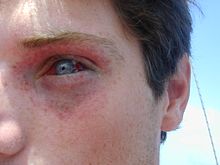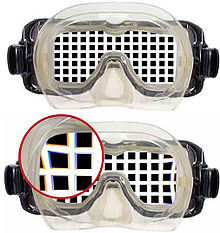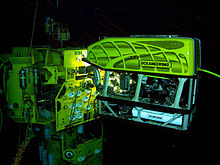Underwater diving
[13] The reduction in finger dexterity due to pain or numbness decreases general safety and work capacity, which in turn increases the risk of other injuries.
As this internal oxygen supply reduces, the animal experiences an increasing urge to breathe caused by buildup of carbon dioxide and lactate in the blood,[16] followed by loss of consciousness due to cerebral hypoxia.
[17] Blackouts in freediving can occur when the breath is held long enough for metabolic activity to reduce the oxygen partial pressure sufficiently to cause loss of consciousness.
A narrow field of vision caused by a small viewport in a helmet results in greatly reduced stereoacuity,[31] and an apparent movement of a stationary object when the head is moved.
When the head is exposed to the water, some sound is transmitted by the eardrum and middle ear, but a significant part reaches the cochlea independently, by bone conduction.
When wearing a helmet, hearing sensitivity is similar to that in surface air, as it is not greatly affected by the breathing gas or chamber atmosphere composition or pressure.
[33] Because sound travels faster in heliox than in air, voice formants are raised, making divers' speech high-pitched and distorted, and hard to understand for people not used to it.
The ability to dive and swim underwater while holding one's breath is considered a useful emergency skill, an important part of water sport and Navy safety training, and an enjoyable leisure activity.
Airline diving is used for work such as hull cleaning and archaeological surveys, for shellfish harvesting, and as snuba, a shallow water activity typically practised by tourists and those who are not scuba-certified.
An ADS is a small one-person articulated submersible which resembles a suit of armour, with elaborate joints to allow bending, while maintaining an internal pressure of one atmosphere.
Commercial diving is industry related and includes engineering tasks such as in hydrocarbon exploration, offshore construction, dam maintenance and harbour works.
They can perform roles including direct combat, reconnaissance, infiltration behind enemy lines, placing mines, bomb disposal or engineering operations.
[80][98][91] An alternative approach was the development of the ADS or armoured suit, which isolates the diver from the pressure at depth, at the cost of mechanical complexity and limited dexterity.
In some cases combinations are particularly effective, such as the simultaneous use of surface orientated or saturation surface-supplied diving equipment and work or observation class remotely operated vehicles.
[94][100] By the late 19th century, as salvage operations became deeper and longer, an unexplained malady began afflicting the divers; they would suffer breathing difficulties, dizziness, joint pain and paralysis, sometimes leading to death.
The development of schedules that are both safe and efficient has been complicated by the large number of variables and uncertainties, including personal variation in response under varying environmental conditions and workload.
Most underwater diving is done in the shallower coastal parts of the oceans, and inland bodies of fresh water, including lakes, dams, quarries, rivers, springs, flooded caves, reservoirs, tanks, swimming pools, and canals, but may also be done in large bore ducting and sewers, power station cooling systems, cargo and ballast tanks of ships, and liquid-filled industrial equipment.
[122][123] An overhead or penetration diving environment is where the diver enters a space from which there is no direct, purely vertical ascent to the safety of breathable atmosphere at the surface.
The restriction on direct ascent increases the risk of diving under an overhead, and this is usually addressed by adaptations of procedures and use of equipment such as redundant breathing gas sources and guide lines to indicate the route to the exit.
The physics and physiology knowledge required is fairly basic, and helps the diver to understand the effects of the diving environment so that informed acceptance of the associated risks is possible.
The physiology relates the physics to the effects on the human body, to provide a basic understanding of the causes and risks of barotrauma, decompression sickness, gas toxicity, hypothermia, drowning and sensory variations.
[146][147] Further training is required to develop the skills necessary for diving in a wider range of environments, with specialised equipment, and to become competent to perform a variety of underwater tasks.
General physical fitness requirements are also often specified by a certifying agency, and are usually related to ability to swim and perform the activities that are associated with the relevant type of diving.
The field includes the effect on the human body of breathing gases and their contaminants under high pressure, and the relationship between the state of physical and psychological health of the diver and safety.
[163] Air embolism is also frequently cited as a cause of death, often as a consequence of other factors leading to an uncontrolled and badly managed ascent, occasionally aggravated by medical conditions.
Diving equipment other than breathing apparatus is usually reliable, but has been known to fail, and loss of buoyancy control or thermal protection can be a major burden which may lead to more serious problems.
[174] The remaining fatalities probably arose as a result of a progressive sequence of events involving two or more procedural errors or equipment failures, and since procedural errors are generally avoidable by a well-trained, intelligent and alert diver, working in an organised structure, and not under excessive stress, it was concluded that the low accident rate in professional scuba diving is due to this factor.
Divers vary considerably in anthropometric dimensions, physical strength, joint flexibility, and other physiological characteristics within the range of acceptable fitness to dive.
[176][177] The professional diver is supported by a surface team, who are available to assist with the out-of-water activities to the extent necessary to reduce the risk associated with them to a level acceptable in terms of the governing regulations and codes of practice.
During the 20th century recreational scuba diving was considered to have generally low environmental impact, and was consequently one of the activities permitted in most marine protected areas.












